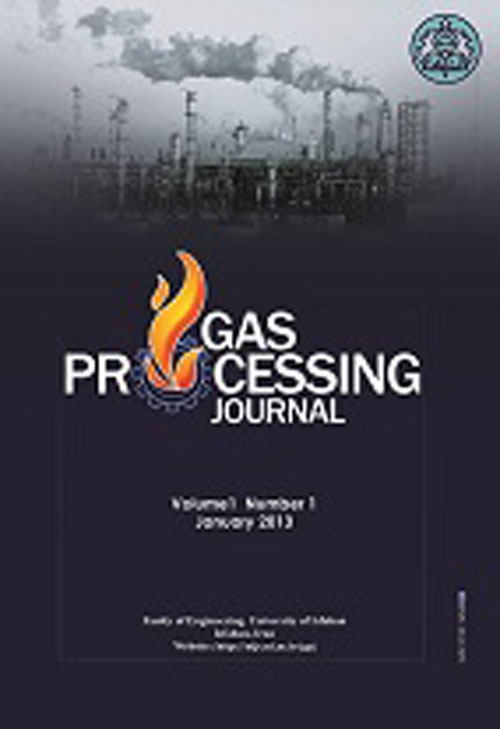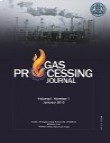فهرست مطالب

Gas Processing Journal
Volume:7 Issue: 2, Autumn 2019
- تاریخ انتشار: 1398/08/10
- تعداد عناوین: 6
-
-
Pages 1-28In this study, optimization of Qeshm power and water desalting cogeneration plant has been investigated. The objective functions are related to maximizing exergetic efficiency and minimization of exergoeconomic and exergoenvironmental parameters. Also, the integration of RO desalination with the existing plant has been evaluated based on these analyses. This plant includes two MAPNA 25 MW gas turbines, two heat recovery steam generators, and two MEDTVC desalination units. Thermodynamic modeling and simulation of the plant have been performed in MATLAB software. The thermodynamic simulation verified by Thermoflex software and plant data with high accuracy. Also, the computer code has been developed to perform exergetic, exergoeconomic and exergoenvironmental analysis. Multi-Objective Genetic Algorithm (MOGA) has been applied to find optimum objective functions and decision variables based on exergetic, exergoeconomic and exergoenvironmental parameters. Results show that in the optimum plant overall exergetic efficiency of the plant has been increased by 27.78%, and total exergetic cost and total exergoenvironmental impacts have been decreased by 0.93% and by 0.89%.Keywords: Cogeneration, MEDTVC desalination, RO desalination, Exergy Analysis, exergoeconomic analysis, exergoenvironmental analysis
-
Pages 29-36Nowadays, natural gas is used as a reliable energy resource around the world. Usually, natural gas requires sweetening processes before consumption and amine units are widely employed for this purpose. Amine unit is used for the separation of acid gases, such as H2S and CO2, from natural gas by means of amine solutions. Energy consumption of amine units is significantly high, due to considerable heating and cooling requirements, and practical methods that reduce energy demand are of interest. In this manuscript, a real amine unit of a gas refinery in Iran has been simulated and simulation results have been compared to actual data, available from the real unit and engineering documents. Simulation results have been found in good agreement with actual industrial data. After simulation validation, the application of multiple inlet amine lines to the absorption column has been examined by several simulations and the optimum location of amine entrance to amine contactor has been investigated. Research results have revealed that by the correct application of multiple lean amine streams, amine circulation rate can be reduced and 11% energy consumption reduction can be achieved. This study has been performed based on actual plant conditions without the usual simplifications used in similar studies.Keywords: Amine Contactor, Lean Amine, Rich Amine, Simulation
-
Pages 37-52As the main aim of this study, simulation and economic assessment of membrane technologies in comparison absorption process for CO2capturing from specified flue gas was conducted. For this purpose, the PRO/II v.10 software and Aspen Process Economic Analyzer v.10 were used. In this simulation, the flue gas flow rate is 8162 kmole/h and the concentration of CO2 in flue gas is 8-22% mole. The objective function in the simulation of CO2 capturing is to remove 85% of CO2 from the flue gas stream. The amount of required solvent and membrane surface, as well as various costs such as equipment costs, installed costs, total capital cost, total utility cost and total operating cost for different concentrations of CO2 in flue gas (8-22% mol.) was assessed for both membrane-based and absorption-based units. For CO2 selectivity and permeability values of 28 and 1097 barrer, respectively, the total capital cost in the membrane-based process is very higher than the absorption process. So, the total capital cost of the membrane unit was about 2.3 times higher than the total capital cost of the absorption process. In a low concentration of CO2, the total utility cost and total operating cost of the membrane-based process were about 2.2 times higher than the absorption process. However, by increasing the CO2 concentration the difference between these costs in two processes decreased. By analyzing the selectivity effects on the total capital costs, it is obtained that with a selectivity value of 280 and the same permeability the costs of the membrane-based process became comparable to the costs of the absorption process.Keywords: CO2 Capture, Membrane separation, Simulation, Economic Evaluation, Absorption method, PRO, II v.10
-
Pages 53-66The release of hydrocarbon and toxic vapor from atmospheric storage tanks is considered as a hazardous phenomenon in the chemical and process industries. Most often, detailed meteorological data for a particular location are unavailable, making the application of Pasquill’s atmospheric stability table the only choice for running simulations. The simulation of the flammable and toxic vapor release and cloud dispersion in South Pars, Iran in the 4th Gas plant incident in 2012, is run by applying the PHAST 6.53.1s/w. Meteorological data extracted from Pasquill's stability table. A simple methodology is developed for assessing land elevation difference between release source and gas detectors the obtained results are validated against time and location of recorded alarms in the site. The atmospheric parameters applied in this simulation are compared with wind speed and sky cloudiness data received from the Iranian meteorological institute. The Pasquill's parameters applied in this simulation are verified against local meteorological recorded data. The results indicate that if the vapor cloud is close to the earth's surface before any major change in the land elevation, this change can be neglected. Sensitivity analysis reveals that there will be fewer consequences if atmospheric discharge direction has a vertical upward orientation.Keywords: Gas Dispersion, Storage Tank, Consequence Simulation, Gas Plant, Flammable, Toxic Gases
-
Pages 67-76Increasing energy cost, reducing the available volume of the conventional fuel and environmental constraints with respect to the emission of the pollutants lead to energy saving as one of the most crucial objectives in the petrochemical plants. Here, both conceptual design (for reducing the fixed cost) and pinch analysis (for reducing the energy cost) of the ethyl benzene production unit are run. An attempt is made to propose a process for ethyl benzene production with only one alkylation reactor instead of two (available in the conventional process). Comparison between the proposed process (integrated reactors) and the conventional process (with two alkylation reactors), reveals an18GJ/h decrease in energy consumption and about 15% in equipment cost. Pinch analysis is run for both the processes and it is found that the energy consumption by this proposed process and the conventional process are reduced from 237.5 GJ/h to 143.87 GJ/h and 255.5 GJ/h to 190.9 GJ/h, respectively. The results indicate that energy consumption in this proposed process is lower than the conventional process before and after pinch analysis.Keywords: Ethyl benzene, Pinch Analysis, Energy minimization, Simulation, Conceptual Design
-
Pages 77-90
In recent years, the use of absorption chillers in air conditioning applications has increased in favor of less power consumption. Since absorption chillers require much less power compared to other common devices in the air conditioning industry, extensive efforts have been made in order to model, design, and optimize these systems. This study has investigated the effect of using solar energy on parallel and series two-stage refrigeration systems. First, both systems were designed, and then by connecting the solar collector to the absorption refrigeration system, the COP of the system and fuel consumption was calculated. Then, the impact of changing the evaporator’s temperature on the system’s COP was studied. The thermodynamic analysis of the system was conducted and the internal variables, such as pressure and temperature of different parts including the condenser and the evaporator, were calculated. Results indicate that the COP of the parallel cycle with a LiBr-H2</sub>O working fluid is higher than that of a series cycle, so this leads to a significant drop in fuel consumption.
Keywords: Absorption Chiller, Solar Energy, LiBr-H2O Refrigerant, Absorption Refrigeration System


